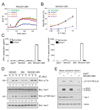Synergistic signals for natural cytotoxicity are required to overcome inhibition by c-Cbl ubiquitin ligase
- PMID: 20189481
- PMCID: PMC2843589
- DOI: 10.1016/j.immuni.2010.02.004
Synergistic signals for natural cytotoxicity are required to overcome inhibition by c-Cbl ubiquitin ligase
Abstract
Natural killer (NK) cell cytotoxicity toward target cells depends on synergistic coactivation by NK cell receptors such as NKG2D and 2B4. How synergy occurs is not known. Synergistic phosphorylation of phospholipase PLC-gamma2, Ca(2+) mobilization, and degranulation triggered by NKG2D and 2B4 coengagement were blocked by Vav1 siRNA knockdown, but enhanced by knockdown of c-Cbl. c-Cbl inhibited Vav1-dependent signals, given that c-Cbl knockdown did not rescue the Vav1 defect. Moreover, c-Cbl knockdown and Vav1 overexpression each circumvented the necessity for synergy because NKG2D or 2B4 alone became sufficient for activation. Thus, synergy requires not strict complementation but, rather, strong Vav1 signals to overcome inhibition by c-Cbl. Inhibition of NK cell cytotoxicity by CD94-NKG2A binding to HLA-E on target cells was dominant over synergistic activation, even after c-Cbl knockdown. Therefore, NK cell activation by synergizing receptors is regulated at the level of Vav1 by a hierarchy of inhibitory mechanisms.
Copyright 2010 Elsevier Inc. All rights reserved.
Figures







References
-
- Acuto O, Michel F. CD28-mediated co-stimulation: a quantitative support for TCR signalling. Nat Rev Immunol. 2003;3:939–951. - PubMed
-
- Anfossi N, Andre P, Guia S, Falk CS, Roetynck S, Stewart CA, Breso V, Frassati C, Reviron D, Middleton D, et al. Human NK cell education by inhibitory receptors for MHC class I. Immunity. 2006;25:331–342. - PubMed
-
- Ardouin L, Bracke M, Mathiot A, Pagakis SN, Norton T, Hogg N, Tybulewicz VLJ. Vav1 transduces TCR signals required for LFA-1 function and cell polarization at the immunological synapse. Eur J Immunol. 2003;33:790–797. - PubMed
-
- Bachmaier K, Krawczyk C, Kozieradzki I, Kong YY, Sasaki T, Oliveira-dos-Santos A, Mariathasan S, Bouchard D, Wakeham A, Itie A, et al. Negative regulation of lymphocyte activation and autoimmunity by the molecular adaptor Cbl-b. Nature. 2000;403:211–216. - PubMed
Publication types
MeSH terms
Substances
Grants and funding
LinkOut - more resources
Full Text Sources
Other Literature Sources
Research Materials
Miscellaneous

